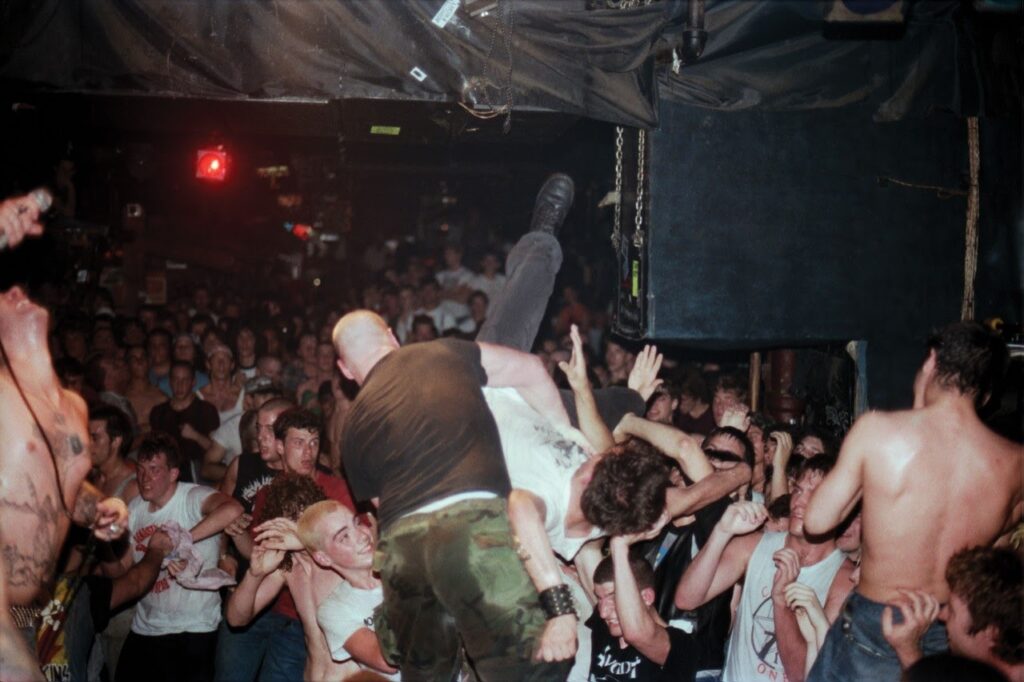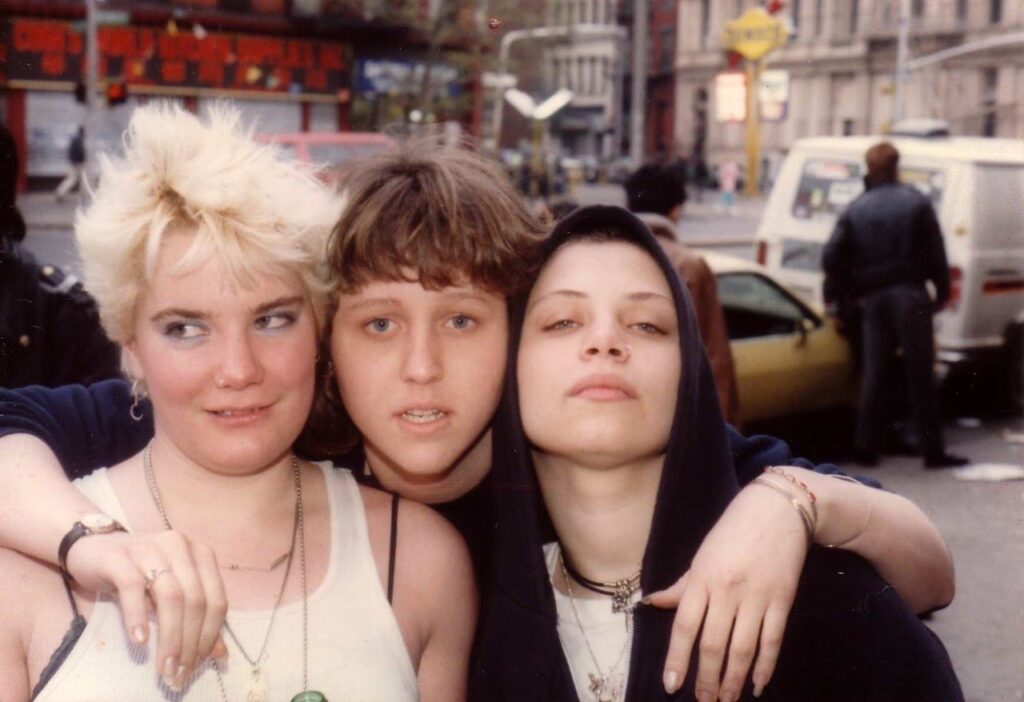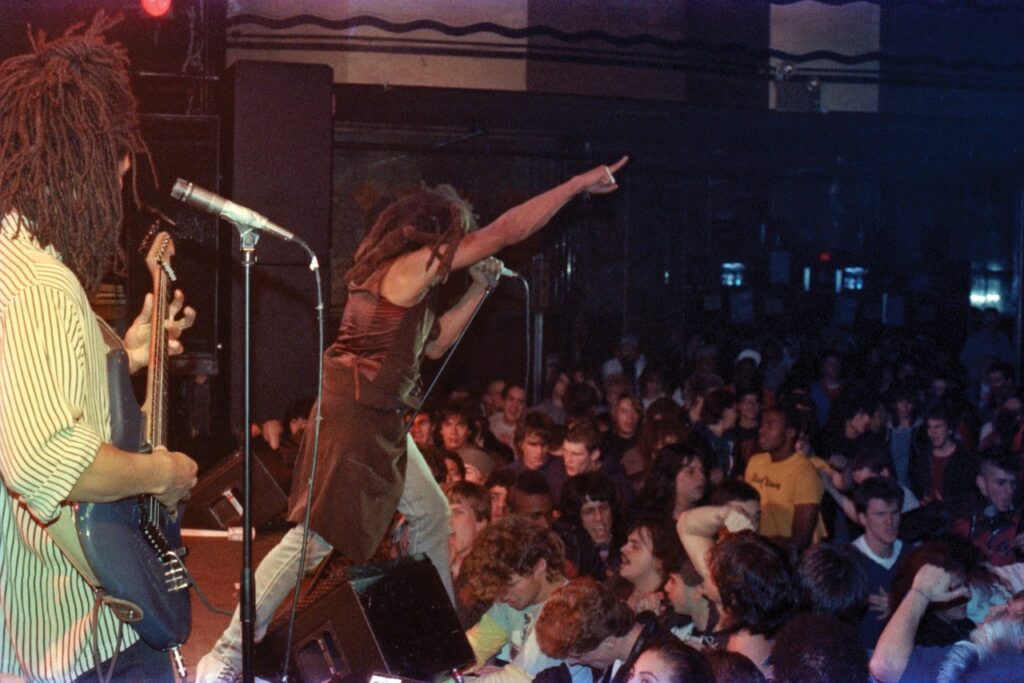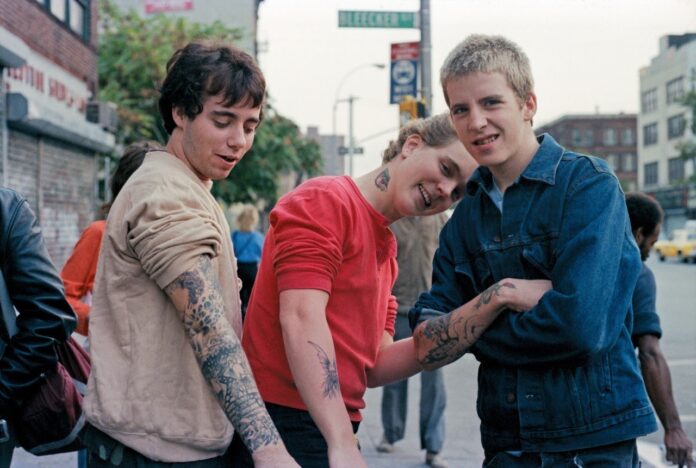Decades before actress Brooke Smith broke through internationally as Catherine Martin in The Silence of the Lambs and local author Laura Albert (subject of the film Author: The JT LeRoy Story) made waves in the literary world as the writer of the novels Sarah, The Heart Is Deceitful Above All Things, and Harold’s End, the pair found their creative voices in New York’s early-’80s hardcore scene.
It was a challenging time for iconoclasts. The nation was run by conservative politics and Dynasty-magnitude materialsm—and even punk (Patti Smith, The Mekons, Crime) had lost its anti-establishment edge and DIY ethics before eventually splintering off into post-punk (Echo and the Bunnymen), New Wave (The B-52s), goth (Bauhaus), industrial (Ministry), and alt-rock (Red Hot Chili Peppers).
To rail against this cultural mainstreaming, a new group of artists like Washington, DC’s Bad Brains and Minor Threat, SoCal’s Black Flag and Circle Jerks, and San Francisco’s Dead Kennedys were doubling down on the faster, harder, more aggressive sound and the in-your-face, politically charged lyrics that would go on to inspire Orange County’s The Offspring and, decades later, SF’s Osees.
Smith and Albert, both native New Yorkers and cultural outsiders, were drawn to Manhattan’s hardcore scene in the then-gritty, heavily graffitied Lower East Side of Alphabet City and Tompkins Square Park.
Smith, an amateur photographer, documented the hardcore bands and their crew-cut and combat-boot sporting fans at iconic clubs like CBGB’s Sunday Matinee. The actress, also known for her roles in Vanya on 42nd Street, “Grey’s Anatomy,” and “Ray Donovan,” has recently organized her impressive photo collection (only previously seen in a 2011 gallery exhibit) in a new book fittingly titled Sunday Matinee.

Albert, then an aspiring artist, was creating comic strips and interviewing musicians from payphones for fanzines. She also distributed records and amassed a legendary collection of fliers (used in Steven Blush’s essential account of the scene, American Hardcore: A Tribal History.)
Before writing her JT LeRoy novels, Albert channeled her hardcore ambitions into fronting the band Daddy Don’t Go—later reborn in the JT LeRoy days as Thistle LLC—alongside her then-partner, guitarist Geoff Knoop (Twist and Scream, 3 Mouse Guitars, GASM). With Knoop, producer Jerry Harrison of Talking Heads, prominent SF musician Prairie Prince, and engineers Karl Derfler and Matt Cohen, Albert recorded covers of two songs by the SF punk band Avengers, “American in Me” and “Corpus Christi,” which captured the rage she felt toward political and religious oppression and hypocrisies.
A San Francisco Public Library series of acclaimed female authors has brought these two artists together for a conversation and reading (Sun/22), to discuss their time in the hardcore scene and examine the music and social movements that fed into it, while exhibiting photos from Sunday Matinee. (Folio Books will be selling signed copies of Smith and Albert’s books at the event.)
Help us save local journalism!
Every tax-deductible donation helps us grow to cover the issues that mean the most to our community. Become a 48 Hills Hero and support the only daily progressive news source in the Bay Area.
I spoke to both about the new photo book, what drew them to the hardcore scene, and how that seminal experience went on to define their attitudes toward life and art.
48 HILLS What drew you to the early-‘80s hardcore scene and Sunday shows at CBGB?
BROOKE SMITH When I was 14 or 15, I met some hardcore kids, went to my first show at CBGB—and knew I had found my people. All these years later, I can see that most of us shared childhood trauma. There was a noise in my head that could only be turned down by going to those shows. The music somehow matched the level of the noise in my head and relieved it a little bit.
LAURA ALBERT I entered the scene the way everyone did—as an act of rebellion and defiance against my family and society in general. I felt an absolute magnetic pull and recognized myself through the immediacy of the music and its subculture. I was hoping to enter into a new kind of family. I ended up in foster care in NYC, which became my family. The excitement was the bands and the crowds they attracted. And there wasn’t that great a distinction—I had friends who were up there and performing soon after they had formed a band.
48 HILLS What was your experience like as young women in this male-dominated scene?
BROOKE SMITH I had been sexually abused, yet I chose to put myself in these dangerous, physical, and intimate settings. The difference is that I made the choice to put myself there. It was a safe space in that we all knew each other and looked out for one another. People talk about it being a male-dominated scene, and it was, but there were girl bands around that I liked, like Scab and PMS. I didn’t feel limited as a woman. If I had been a little braver, I could’ve had my own band. I met incredible women there who are still some of my closest friends.
LAURA ALBERT I wished that I could have been part of this scene as a boy, but that was not possible for me. As a self-conscious overweight girl, I didn’t have the confidence to do the things I saw the boys doing. I was very moved by the protection offered to me by the most powerful boys there, but I limited myself and the ways I could engage people.
48 HILLS Brooke, what made you decide to pick up your Minolta and take photos? What had you planned on doing with them?
BROOKE SMITH Shooting shows was my way to get right to the center of the action—but still keep myself hidden since I was so insecure about myself. I was trying to capture this scene and what it meant to me. I never planned to do anything with the photographs except maybe make band flyers.

48 HILLS Your photographs demonstrate that the scene outside the club was as interesting as what was going on inside.
BROOKE SMITH There were different types of kids—those who wanted to party and do drugs, straight edge ones who were sober and sometimes even celibate, politically active ones … We had our interests and dramas and intrigues, like any other group of young people.
48 HILLS You hung on to your photos for decades before assembling the book. How did you feel about unearthing the box of photos all those years later?
BROOKE SMITH When I first found the box of photos, I didn’t think anyone else would be interested in them. They certainly weren’t interested back when I took them! To me, they are a love letter to that time and place in my life.
48 HILLS What made you decide to produce the book and what was your experience of putting it together?
BROOKE SMITH I have wanted to put a book together since I had the gallery show in New York 12 years ago. It was very hard to select the images and find the flow of the book. I’m 55 now— maybe it took that long for me to have enough distance to examine that time in my life.
48 HILLS In which ways are you still similar to the woman you were then, and in which ways are you different? Are there throughlines between those days and the artist that you became?
BROOKE SMITH I feel like the same person in so many ways. The New York hardcore scene helped me become an actress because there was no separation between the audience and the performers. As an actor or an audience member, I have always preferred intimate theatrical experiences. Authenticity was very important—being true to who you are and sharing your truth with the world—and I still try very hard to be true to myself in the roles I choose, and portray the characters as honestly as I can.
LAURA ALBERT The hardcore punk spirit was an essential part of the creation of my literary avatar, JT LeRoy. Permission was not asked; we just did it in the way we needed to do it.
There was no rockstar hierarchy in the scene—I could be a fanzine journalist and call up important figures like Mike Muir from Suicidal Tendencies.
I was friends with Tim Sommer whose WNYU “Noise The Show” was my lifeline, along with Pat Duncan on WFMU. These were places to hear what was going on in the punk scenes all over the world. I also got very into the New Jersey hardcore scene and coproduced with James James Reynolds a record of some NJ bands—TMA was just rereleased.
It’s funny, I was 17 and in a psych ward, and bands would come in to drop off their master tapes. For them it was no big deal that their producer would be A) a kid and B) in a mental ward. So many kids in the scene were being placed in hospitals because everyone was scared of us.
The DIY, don’t-wait-for-permission approach, has continued to be essential to me. Your creativity wasn’t limited to being in a band; it was multi-faceted. At age 15, I was running my own mail-order firm for distributing records. I was also making comic strips and interviewing bands for fanzines.

48 HILLS What can younger people learn from New York’s hardcore scene?
BROOKE SMITH That you have to go out and make your own scene—and you can do that anywhere. It’s harder than ever to feel connected these days. So maybe I would want younger generations to just get out more and see the world in person, not from behind their laptops.
LAURA ALBERT The rage that fueled this scene has not gone away. The offenses, in many ways, are worse than ever. Only now is society developing a vocabulary to recognize and discuss the physical and sexual abuse being suffered by young people. Being an abuse survivor was a common denominator—although unsaid—for almost everyone in this scene.
Dialogue: Brooke Smith and Laura Albert, Sunday Matinee Sun/22, 3pm, Main Library, 100 Larkin, SF. More info here.
Registration is required for Zoom attendance. In-person attendance does not require registration; seats are available first come, first served.






